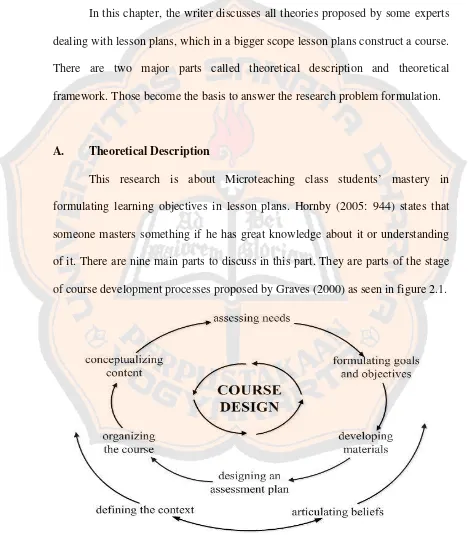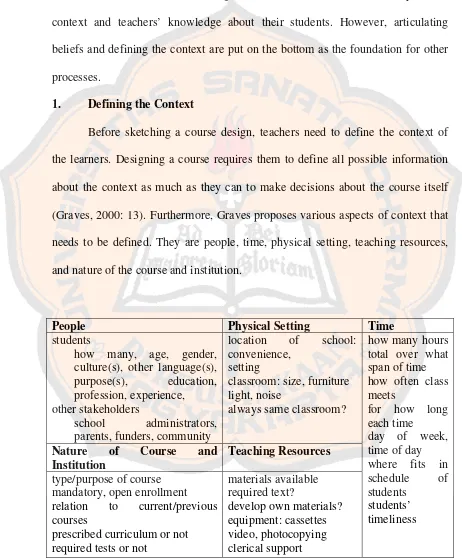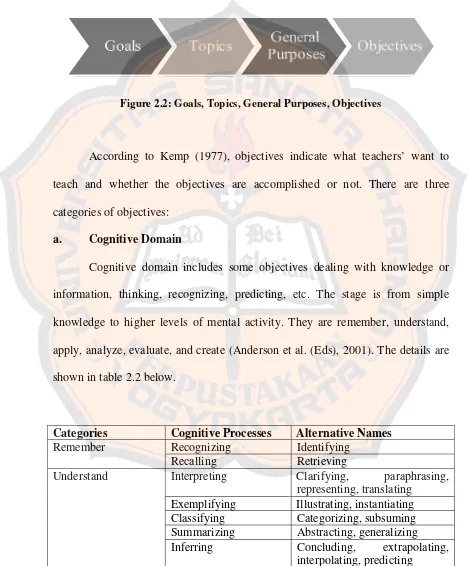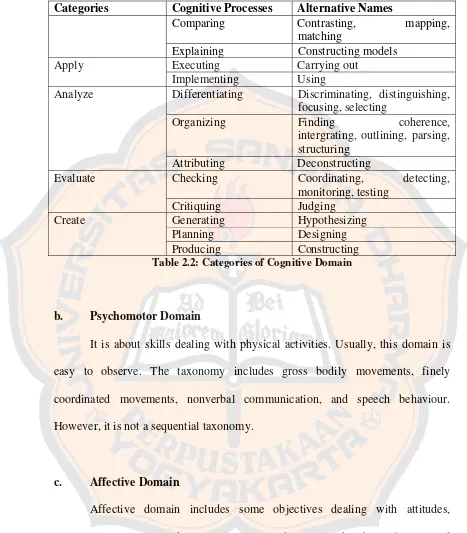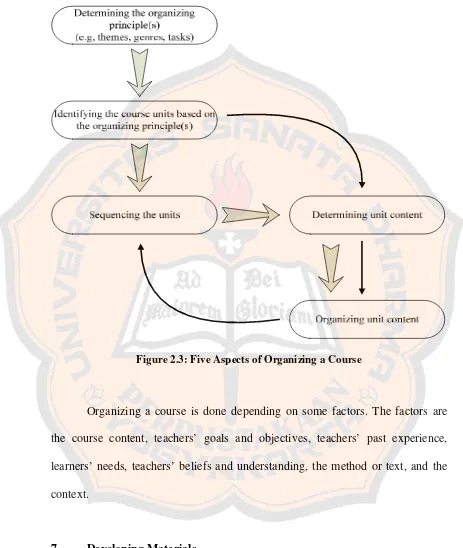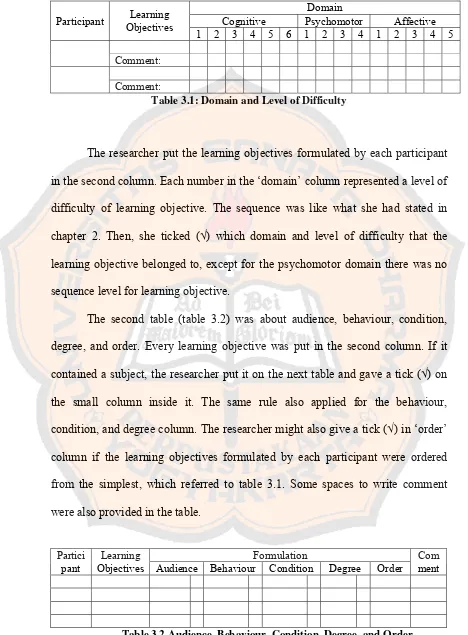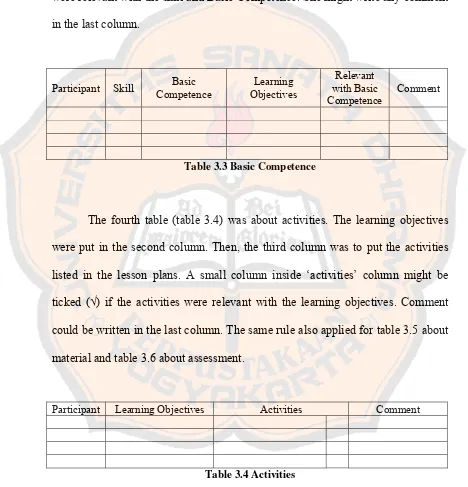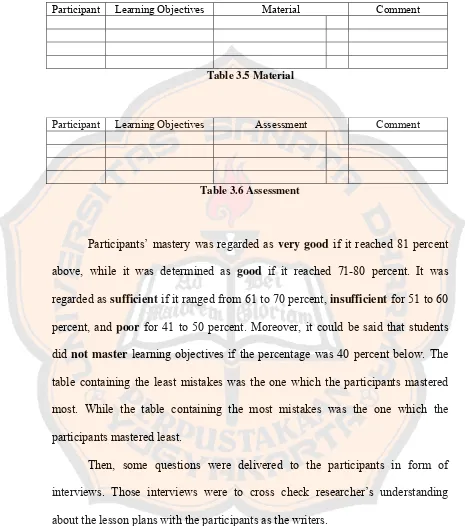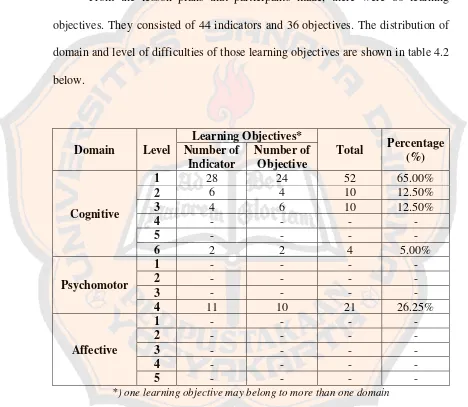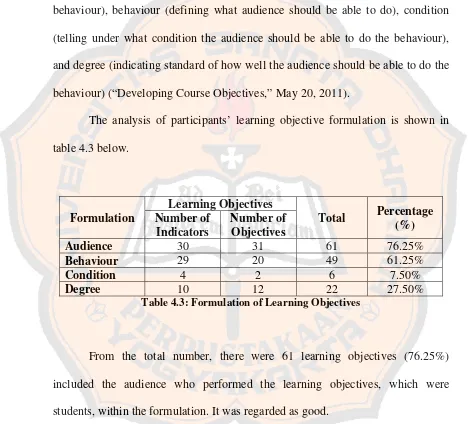THE MASTERY OF MICROTEACHING CLASS STUDENTS
IN FORMULATING LEARNING OBJECTIVES IN LESSON PLANS
A THESIS
Presented as Partial Fulfillment of the Requirements
to Obtain the Sarjana Pendidikan Degree
in English Language Education
By
Leonie Irina Mutiara
Student Number: 071214030
ENGLISH LANGUAGE EDUCATION STUDY PROGRAM
DEPARTMENT OF LANGUAGE AND ARTS EDUCATION
FACULTY OF TEACHERS TRAINING AND EDUCATION
SANATA DHARMA UNIVERSITY
YOGYAKARTA
2011
PLAGIAT MERUPAKAN TINDAKAN TIDAK TERPUJI
PLAGIAT MERUPAKAN TINDAKAN TIDAK TERPUJI
In His time,
God has made all things beautiful
In His time,
In His own time
Ecclesiastes 3: 11
PLAGIAT MERUPAKAN TINDAKAN TIDAK TERPUJI
ABSTRACT
Mutiara, Leonie Irina. 2011. The Mastery of Microteaching Class Students in
Formulating Learning Objectives in Lesson Plans. Yogyakarta: Sanata Dharma
University.
This research aimed to figure out how well Microteaching class students
formulated learning objectives in lesson plans as well as to find out what
problems might occur in their formulation. There were two research questions
presented in this study: (1) How is the students’ mastery in formulating learning
objectives? (2) What problems might occur in students’ learning objective
formulation?
To answer the research questions, the researcher conducted document
analysis. The documents analyzed were students’ lesson plans which were used
for their teaching practice in Microteaching class in 2010/2011 academic year.
Then, the learning objectives which were found in those lesson plans were
categorized based on some requirements of good learning objectives and were
judged how well they were. Furthermore, the researcher would also discuss
problems that might occur in the learning objectives.
From the analysis, the researcher concluded that students’ mastery in
formulating learning objective was various depending on the requirements.
Participants’ mastery was good (76.25%) in audience element and insufficient
(61.25%) in behaviour element. However, participants did not master learning
objective formulation dealing with condition (7.50%) and degree element
(27.50%). In another side, their mastery was very good (93.75%) in formulating
learning objectives which were derived from the Basic Competence, very good
(86.25%) in formulating learning objectives which were relevant with the
activities, very good (96.25%) in formulating learning objectives which were
relevant with the materials, and good (78.75%) in formulating learning objectives
which were relevant with the assessments. Then, the researcher also found some
problems in the learning objectives. The formulation was not clear, complete, and
well-ordered. Other problems were also caused by the irrelevancy between the
learning objectives and the Basic Competence, the learning objectives and the
activities, the learning objectives and the materials, and the learning objectives
and the assessments. Besides, learning objectives having no activities and
assessments were also included as problems in this research.
In brief, participants’ teaching preparation in Microteaching class which
was presented from their lesson plans was regarded as good enough, which
supported their teaching performance. They were ready to be English teachers.
Then, the researcher also addressed some suggestion to lecturers, students, and
future researcher.
ABSTRAK
Mutiara, Leonie Irina. 2011. The Mastery of Microteaching Class Students in
Formulating Learning Objectives in Lesson Plans. Yogyakarta: Universitas
Sanata Dharma.
Penelitian ini bertujuan untuk mengetahui seberapa baik mahasiswa kelas
Pengajaran Mikro merumuskan objektif pembelajaran dalam RPP mereka dan
untuk menemukan masalah yang mungkin terjadi dalam rumusan tersebut. Ada
dua pertanyaan dalam penelitian ini: (1) Seberapa baik penguasaan mahasiswa
dalam merumuskan objektif pembelajaran? (2) Masalah apa yang mungkin terjadi
dalam rumusan objektif pembelajaran mahasiswa?
Untuk mejawab pertanyaan-pertanyaan tersebut, peneliti mengadakan
analisis dokumen. Dokumen yang dianalisis adalah RPP mahasiswa yang
digunakan untuk praktek mengajar mereka di kelas Pengajaran Mikro tahun ajaran
2010/2011. Lalu, rumusan objektif pembelajaran yang ditemukan dalam RPP
tersebut dikategorikan berdasarkan beberapa syarat objektif pembelajaran yang
baik dan dinilai seberapa baik objektif pembelajaran tersebut. Selanjutnya,
peneliti juga mendiskusikan masalah-masalah yang mungkin ditemukan dalam
objektif pembelajaran tersebut.
Dari hasil analisis, peneliti menyimpulkan bahwa penguasaan mahasiswa
dalam merumuskan objektif pembelajaran berbeda-beda, tergantung syaratnya.
Penguasaan peserta bagus (76.25%) dalam elemen audience
dan tidak cukup
(61.25%) dalam elemen behaviour. Tetapi, peserta tidak menguasai objektif
pembelajaran yang berhubungan dengan elemen condition (7.50%) dan degree
(27.50%). Di sisi lain, penguasaan mereka sangat bagus (93.75%) dalam
merumuskan objektif pembelajaran yang diturunkan dari Kompetensi Dasar,
sangat bagus dalam merumuskan objektif pembelajaran yang relevan dengan
aktifitas (86.25%) dan materi (96.25%), dan bagus (78.75%) dalam merumuskan
objektif pembelajaran yang relevan dengan penilaiannya. Lalu peneliti juga
menemukan beberapa masalah dengan objektif pembelajaran. Rumusannya tidak
jelas, komplit, dan urut. Masalah lainnya juga disebabkan oleh ketidakrelevanan
antara objektif pembelajaran dan Kompetensi Dasar, objektif pembelajaran dan
aktifitas, objektif pembelajaran dan materi, dan objektif pembelajaran dan
penilaian. Di samping itu, masalah juga timbul karena objektif pembelajaran tidak
mempunyai aktifitas pendukung dan tidak menyebutkan penilaianmya.
Secara singkat, persiapan mengajar peserta di kelas Pengajaran Mikro
yang direpresentasikan dari RPP yang dibuatnya, cukup baik. Hal ini mendukung
performa mengajar mereka. Mereka siap menjadi calon guru bahasa Inggris.
Kemudian, peneliti juga memberikan beberapa saran untuk dosen, mahasiswa, dan
peneliti lainnya.
Kata kunci: kelas Pengajaran Mikro, objektif pembelajaran, RPP
PLAGIAT MERUPAKAN TINDAKAN TIDAK TERPUJI
ACKNOWLEDGEMENTS
First of all, I would like to express my greatest gratitude to the Almighty
God for always guiding and blessing me. He always gives everything I need. I
believe a bright future is prepared for me. Without Him, I will be nothing.
My sincere appreciation goes to my sponsor, Caecilia Tutyandari, S.Pd.,
M.Pd., for guiding, giving suggestions, and supporting me during my finishing
this thesis. I would like also to express my gratefulness to Microteaching
lecturers, Ag. Hardi Prasetyo, S.Pd., M.A., Caecilia Tutyandari, S.Pd., M.Pd.,
Carla Sih Prabandari, S.Pd., M.Hum., Made Frida Yulia, S.Pd., M.Pd., Christina
Kristiyani, S.Pd., M.Pd., and V. Triprihatmini, S.Pd., M.Hum., M.A., for giving
permission to access the data I needed. Moreover, I thank Microteaching class
students of 2010/2011 academic year for their willingness to help me copy their
lesson plans.
Sincere love and gratitude is also expressed to my parents, Bapak Drs.
Wardani Sugiyanto, M.Pd. and Ibu Dra. Listyawati Sri Rahayuningsih, for their
love, prayer, kindness, and support. I also thank my beloved sisters, Nada Dian
Sejati and Intan Ayu Nugraha, for making me laugh and always cheerful. Not to
forget, my great thankfulness goes to my beloved boyfriend, Surya Adi Prasetya
Nugraha, for his love, time, and support.
I owe much to my friends, Adaninggar Septi Subekti and Ariesty
Nevryani, for their willingness to share their knowledge. My next appreciation is
for Surya 180 crews for our togetherness and for Herdiansari Hayuningrum,
PLAGIAT MERUPAKAN TINDAKAN TIDAK TERPUJI
Ernesa Novita, Widya Warasita, Lusia Ping, and Kudus Martha Uli for being my
friends and work partner in Nuswantara English Course.
At last, my deepest appreciation also goes for many other names whose
names cannot be mentioned one by one. I thank them for helping and supporting
me in finishing my thesis. May God bless us.
TABLE OF CONTENTS
Page
TITLE PAGE ………. i
APPROVAL PAGES ………... ii
DEDICATION PAGE ………... iv
STATEMENT OF WORK’S ORIGINALITY ……….. v
ABSTRACT ……….. vi
ABSTRAK ……….… vii
LEMBAR PERNYATAAN PERSETUJUAN PUBLIKASI ………... viii
ACKNOWLEDGEMENTS ……….. ix
TABLE OF CONTENTS ……….. xi
LIST OF TABLES ………..… xiii
LIST OF FIGURES ……….... xiv
LIST OF APPENDICES ……….. xv
CHAPTER I.
INTRODUCTION
A.
Research Background ……….. 1
B.
Problem Formulation ………... 3
C.
Problem Limitation ………..… 3
D.
Research Objectives ………. 3
E.
Research Benefits ……….... 4
F.
Definitions of Terms ……….…... 4
CHAPTER II.
LITERATURE REVIEW
A.
Theoretical Description ……….... 7
1.
Defining the Context ………. 8
2.
Articulating Beliefs ……… 9
3.
Conceptualizing Content ………..… 14
4.
Formulating Goals and Objectives ………... 15
5.
Assessing Needs ………... 18
PLAGIAT MERUPAKAN TINDAKAN TIDAK TERPUJI
6.
Organizing the Course ………..… 19
7.
Developing Materials ………... 20
8.
Adapting a Textbook ……… 22
9.
Designing an Assessment Plan ………... 23
B.
Theoretical Framework ……….. 24
CHAPTER III.
METHODOLOGY
A.
Research Methods ……….. 26
B.
Research Participants ………. 26
C.
Research Instruments ………. 27
D.
Data Gathering Technique ………. 29
E.
Data Analysis Technique ………... 29
F.
Research Procedure ……… 33
CHAPTER IV.
RESEARCH FINDINGS AND DISCUSSION
A.
Microteaching Students’ Mastery ……….. 34
B.
Problems that Might Occur
in Students’ Learning Objective Formulation ……… 41
CHAPTER V.
CONCLUSIONS AND SUGGESTIONS
A.
Conclusions ………...…. 50
B.
Suggestions ………...……. 52
REFERENCES ………. 54
LIST OF TABLES
Table
Page
2.1: Factors to Consider in Defining the Context ……...………...……...…. 8
2.2: Categories of Cognitive Domain ……….………...………..…. 16
3.1: Domain and Level of Difficulty ………..…….. 30
3.2: Audience, Behaviour, Condition, Degree, and Order ………...….. 30
3.3: Basic Competence …………...………..…… 31
3.4: Activities …………...……….... 31
3.5: Material ...………..….... 32
3.6: Assessment ……...………...………..…… 32
4.1: Number of Learning Objectives ………..…….. 35
4.2: Domain and Level Distribution of Learning Objectives ………..….… 35
4.3: Formulation of Learning Objectives ………..…... 37
4.4: Set of Learning Objectives ………...….… 39
4.5: Ordered Set of Learning Objectives ……….….... 39
4.6: Relevancy with Basic Competence, Activities,
Materials, and Assessment……….. 40
4.7: The Classifications of Problems ………...…………. 41
PLAGIAT MERUPAKAN TINDAKAN TIDAK TERPUJI
LIST OF FIGURES
Figure
Page
LIST OF APPENDICES
Appendix
Page
1.
Surat Permohonan Ijin Penelitian ………...…….. 55
2.
The Category of Learning Objectives ……… 62
PLAGIAT MERUPAKAN TINDAKAN TIDAK TERPUJI
CHAPTER I
INTRODUCTION
This chapter consists of six major sections. They are research background,
problem formulation, problem limitation, research objectives, research benefits,
and definitions of terms.
A.
Research Background
English Language Education is a study program under Teachers Training
and Education Faculty in Sanata Dharma University. This study program, English
Language Education Study Program (ELESP), which is known as Program Studi
Pendidikan Bahasa Inggris (PBI), aims to prepare future English teachers who
have four competences; professional, pedagogic, personal, and social (Panduan
Akademik Program Studi PBI, 2007). The students are expected not only to use
the language itself, but also to teach the language to others. They are trained and
educated to be English teachers. They have to acquire the language and learn how
to teach before they teach it.
2
English. Some of the courses are Approaches, Methods, and Techniques (AMT),
Language Teaching Media (LTM), Instructional Design (ID), and Curriculum and
Material Development (CMD).
However, theories will not be enough for good English teachers. They
need to apply what they have learnt. Thus, in the sixth semester, the study
program offers a course called Microteaching. It is a class for students to practice
teaching and apply what they have learned in the prior semesters.
In that class, Microteaching students have to develop lesson plans for their
teaching practice. They are expected to be able to apply the theories that they have
learnt, especially on how to develop lesson plans well. In a lesson plan, a teacher
should state one or more learning objectives, which are derived from general
purposes (Kemp, 1977). In School-based Curriculum, they are called Basic
Competence. Learning objectives, in this research referring to learning objectives
themselves and learning indicators stated in lesson plans, are learning outcomes or
something that students are able to demonstrate at the end of instruction to show
that the learning expectation is reached (Gronlund, 1991: 3). They are to measure
whether Microteaching students accomplish certain targets.
Each meeting requires a lesson plan. In preparing teaching materials,
activities, and assessment, teachers should base on the learning objectives. In
other words, the learning objectives lead teachers to what should be taught in a
meeting, how to teach it, and how to assess learners. Learning objectives become
the measurement whether a teaching reaches its goal or not.
PLAGIAT MERUPAKAN TINDAKAN TIDAK TERPUJI
Since learning objective is important to measure learning achievement, it
must be formulated well. However, some mistakes are still found. Thus, the study
of Microteaching students’ mastery on the formulation of learning objectives is
conducted to know how well they master the theories to formulate good learning
objectives, which is expressed through their learning objectives formulation and
its relevancy with the general purpose, activities, materials, and assessment.
B.
Problem Formulation
The formulation of the problems can be stated as follows:
1.
How is the students’ mastery in formulating learning objectives?
2.
What problems might occur in students’ learning objective formulation?
C.
Problem Limitation
In this study, the writer analyzes the learning objectives formulated by
Microteaching class students, which are represented by 18 students. The data are
taken from their lesson plans. Any mistake in grammar, spelling, and punctuation
will be disregarded.
D.
Research Objectives
Dealing with the two problem formulation mentioned previously, this
study is conducted to achieve these objectives:
4
2.
To find out problems that may occur in students’ learning objective
formulation.
E.
Research Benefits
This research is expected to give benefits to both students and lecturers.
For the students, the research shows them how well their mastery in formulating
learning objectives so that they know which part should be improved. It also lets
them know some common problems that may occur in their learning objectives. It
is expected that by learning from their problems, students will be more careful in
formulating objectives and make some improvements on it later.
Also, by knowing which part of students’ difficulties in formulating
learning objectives, lecturers would find it easier to teach them based on their
needs and weaknesses.
F.
Definitions of Terms
It is important to define some terms used in this study to avoid
misunderstanding and to lead readers to a better understanding on the topic being
discussed. The terms are as follows:
1.
Mastery
According to Hornby (2005: 944), mastery is a great knowledge about
something or understanding of a particular thing. In this research, mastery refers
to Microteaching students’ understanding of learning objectives, which are
observed through their learning objective formulation and its relevancy with the
PLAGIAT MERUPAKAN TINDAKAN TIDAK TERPUJI
general purpose, activities, materials, and assessments stated in their lesson plans
that they make for teaching practice in Microteaching class. Thus, students master
learning objectives if they can show the relevancy between their learning
objectives and the general purpose, activities, materials, and assessments in their
lesson plans.
2.
Learning Objectives
The next term which is important to define is ‘learning objectives’.
Gronlund (1991: 3) states that learning objectives, usually called as instructional
objectives, are intended learning outcomes or something that students are able to
demonstrate at the end of instruction to show that the learning expectation is
reached. In this research, learning objectives refer to learning objectives
themselves and learning indicators, which are considered as learning expectation
or learning outcome stated in lesson plan for Microteaching class students’
teaching purpose.
3.
Microteaching Class
6
classroom teaching situation through Program Pengalaman Lapangan (PPL),
which is either in Junior, Senior, or Vocational High School.
PLAGIAT MERUPAKAN TINDAKAN TIDAK TERPUJI
CHAPTER II
LITERATURE REVIEW
In this chapter, the writer discusses all theories proposed by some experts
dealing with lesson plans, which in a bigger scope lesson plans construct a course.
There are two major parts called theoretical description and theoretical
framework. Those become the basis to answer the research problem formulation.
A.
Theoretical Description
8
There is no sequence or hierarchy in the processes. Teachers may start the
process anywhere in the framework as long as it is reasonable. It depends on
teachers’ beliefs and understanding, articulated or not, and the reality of the
context and teachers’ knowledge about their students. However, articulating
beliefs and defining the context are put on the bottom as the foundation for other
processes.
1.
Defining the Context
Before sketching a course design, teachers need to define the context of
the learners. Designing a course requires them to define all possible information
about the context as much as they can to make decisions about the course itself
(Graves, 2000: 13). Furthermore, Graves proposes various aspects of context that
needs to be defined. They are people, time, physical setting, teaching resources,
and nature of the course and institution.
People Physical
Setting
Time
students
how many, age, gender,
culture(s), other language(s),
purpose(s), education,
profession, experience,
other stakeholders
school administrators,
parents, funders, community
location of school:
convenience,
setting
classroom: size, furniture
light, noise
always same classroom?
how many hours
total over what
span of time
how often class
meets
schedule of
students
students’
timeliness
Nature of Course and
Institution
Teaching Resources
type/purpose of course
mandatory, open enrollment
relation to current/previous
courses
prescribed curriculum or not
required tests or not
materials available
required text?
develop own materials?
equipment: cassettes
video, photocopying
clerical support
Table 2.1: Factors to Consider in Defining the Context
PLAGIAT MERUPAKAN TINDAKAN TIDAK TERPUJI
Those aspects mentioned above are used by teachers as resources and
constraints to consider their decisions. It can be seen as part of pre-course needs
assessment. More information about the context enables teachers to decide and
plan an effective course easier. Furthermore, Richards (2001: 90) talks about the
diversity of the contexts for language programs. The success of a program is often
determined by the particular variables found in every specific situation.
A teacher wants to design a course, for example. Before he decides the
content, objectives, and so on, he needs to know how long the course will be, who
the students are, what is their backgrounds knowledge, what the purpose is, where
it is conducted, etc. Those are the context that helps and support the teacher in
designing a course.
During the observation of the context, Graves (2000: 21) says that
challenges may be found. Furthermore, Graves states that more challenges are
found when teachers have more information about the context. The challenges
may include teacher’s lack of experience, too small class, different level of each
learner, and so on. This is called problematizing. Problematizing concerns with
making choices and deciding what the best solution to the challenges is.
Problematizing helps teachers to design and teach a course better.
2.
Articulating Beliefs
10
(Graves 2000: 26). As cited by Graves (2000), Stern proposes four concepts in
articulating teachers’ beliefs. They are view of language, view of the social
context of the language, view of learning and learners, and view of teaching.
a.
Beliefs about Language
Teachers’ views of a language lead them to a way how they teach or how
the language should be learned and what they teach (Graves 2000: 28). According
to Hutchinson and Waters (1987), there are six main stages of development of
language descriptions.
i.
Classical or Traditional Grammar
Classical or traditional grammar view believes that all languages are
descended from Greek and Latin. Thus, the grammar of the languages should be
based on the grammars of those two languages.
ii.
Structural Linguistics
According to this stage, language is about fundamental propositions
(statement, interrogative, negative, imperative, etc) and notions (time, number,
gender, etc) which are carried by the syntagmatic structures. It means that
sentences with different meanings can be produced through words within those
structural frameworks variations.
iii.
Transformational Generative Grammar
In this view of language, Chomsky states that there must be two levels of
meaning; they are deep level and surface level. Deep level is about both thoughts
and a surface level organization, whereas surface level is the expression of
thoughts through the syntax of language. Thus, grammar of a language is seen as
PLAGIAT MERUPAKAN TINDAKAN TIDAK TERPUJI
the rules enabling people to produce the surface structures from the deep level of
meaning.
iv.
Language Variation and Register Analysis
Language varies depending on the context. So the kind of language
dealing with a specific context, such as an area of knowledge (medical English,
business English, scientific English) can be identified through the language used
itself then.
v.
Functional/Notional Grammar
This view of language sees language as a mean of communication which
conveys social function and people’s attention. Function deals with social
behaviour and speaker’s/writer’s intention, like advising, warning, describing, etc.
vi.
Discourse/Rhetorical Analysis
The meaning of a language is concluded from the context of the sentences.
Different context causes different meaning in the same sentence.
b.
Beliefs about the Social Context of Language
i.
Sociolinguistic Issues
12
ii.
Sociocultural Issues
Language use is associated with understanding of each language user’s
dimensions of culture. They include social values, attitudes, norms, customs, and
“products” (e.g. literature, art).
iii.
Sociopolitical Issues
Those issues are concerned with how language used affects one’s relation
with other community or social group. Language teaching deals with teach
learners how to participate in the community and get access to social systems.
c.
Beliefs about Learning and Learners
Hutchinson and Waters (1987) divide theories of learning into five main
stages of development.
i.
Behaviourism
Language learning is seen as changing behaviour. It is a mechanical
process of habit formation in which the basic exercise technique is pattern
practice, particularly drills.
ii.
Mentalism
Learning is not only forming habits like the previous stage does. Learning
is a process of acquiring rules in which learners’ minds formulate hypothesis
through their individual experiences.
PLAGIAT MERUPAKAN TINDAKAN TIDAK TERPUJI
iii.
Cognitive Code
It is often called as constructivism learning. Learners construct their own
knowledge from their experience together with other people through making sense
of data. Teachers’ role is as facilitator to provide learners experience.
iv.
The Affective Factor
Language learning will be well-done if learners have motivation since it
is an emotional experience. They must ‘want to think about something’ that they
will learn.
v.
Learning and Acquisition
According to Krashen (1981) as cited by Graves (2000), learning and
acquisition are two different things. Learning is a conscious process, whereas
acquisition is an unconscious one.
d.
Beliefs about Teaching
14
3.
Conceptualizing Content
Conceptualizing content is about making choices. It is a process involving
thinking about what teachers want their students to learn, deciding what to
include, and organizing the content in a such way that the various elements on it
are related each other. The result of the conceptualizing content is in a form of
syllabus.
According to Hutchinson and Waters (1987), syllabus can be defined in
several different ways. They are:
a.
Evaluation Syllabus
Evaluation Syllabus states what learners should know by the end of the
course in order to be successful. Thus, a syllabus designer should understand first
what his view of language actually is.
b.
Organisational Syllabus
This syllabus tells about the order of what should be learnt. The nature of
language and of learning is stated implicitly here.
c.
Materials Syllabus
Material syllabus contains more assumptions about the nature of language,
language learning, and language which are expressed through learning activities.
d.
Teacher Syllabus
Teacher syllabus is seen from the teachers’ perspective. It is the teachers
who influence the clarity, intensity, and frequency of any material.
PLAGIAT MERUPAKAN TINDAKAN TIDAK TERPUJI
e.
Classroom Syllabus
Sometimes what is planned goes differently with what really happens in a
lesson. What is meant by classroom syllabus is what actually happens in the real
class during the lesson.
f.
Learner Syllabus
Learner syllabus may be different in each learner. This syllabus takes
place in each learner’s mind during the lesson. It is about knowledge developing
in learners’ brain and enabling them to comprehend and store the later knowledge.
4.
Formulating Goals and Objectives
Goals are statements of the main purpose and intended outcomes of a
course. According to Kemp (1977), goals can be created from three sources,
which are society, students, and subject areas. Goals related to society involve
philosophical and ethical considerations. Goals related to students deal with
students’ skill or behaviour concerning their preparation to face the working
world. Goals related to subject areas have relation with competencies that enable
learners to participate in society well, or may be as the bases for the understanding
and skills expected by the society. Formulating goals is based on teachers’
conceptualization of content, beliefs, and/or teachers’ assessment of learners’
needs.
16
and observed. Those are called objectives. Thus, objectives must be related to
goals, topics, and general purposes.
Figure 2.2: Goals, Topics, General Purposes, Objectives
According to Kemp (1977), objectives indicate what teachers’ want to
teach and whether the objectives are accomplished or not. There are three
categories of objectives:
a.
Cognitive Domain
Cognitive domain includes some objectives dealing with knowledge or
information, thinking, recognizing, predicting, etc. The stage is from simple
knowledge to higher levels of mental activity. They are remember, understand,
apply, analyze, evaluate, and create (Anderson et al. (Eds), 2001). The details are
shown in table 2.2 below.
Categories Cognitive
Processes
Alternative
Names
Remember Recognizing Identifying
Recalling Retrieving
Understand Interpreting Clarifying, paraphrasing,
representing, translating
Exemplifying Illustrating,
instantiating
Classifying Categorizing,
subsuming
Summarizing Abstracting, generalizing
Inferring Concluding, extrapolating,
interpolating, predicting
PLAGIAT MERUPAKAN TINDAKAN TIDAK TERPUJI
Categories Cognitive
Processes
Alternative
Names
Comparing Contrasting,
mapping,
matching
Explaining Constructing
models
Apply Executing
Carrying
out
Implementing Using
Analyze Differentiating
Discriminating, distinguishing,
focusing, selecting
Organizing Finding
coherence,
intergrating, outlining, parsing,
structuring
Attributing Deconstructing
Evaluate Checking Coordinating,
detecting,
monitoring, testing
Critiquing Judging
Create Generating
Hypothesizing
Planning Designing
Producing Constructing
Table 2.2: Categories of Cognitive Domainb.
Psychomotor Domain
It is about skills dealing with physical activities. Usually, this domain is
easy to observe. The taxonomy includes gross bodily movements, finely
coordinated movements, nonverbal communication, and speech behaviour.
However, it is not a sequential taxonomy.
c.
Affective Domain
18
complex. Furthermore, Kemp states that a learning objective can involve one or
more domains.
Furthermore, a good formulation of learning objective should include four
elements which are known as ABCD. A stands for audience, which indicates who
will do the behaviour. B stands for behaviour, defining what audience should be
able to do. C stands for condition, telling under what condition the audience
should be able to do the behaviour. D stands for degree, indicating standard of
how well the audience should be able to do the behaviour (“Developing Course
Objectives,” May 20, 2011).
5.
Assessing Needs
Needs assessment is a process in which teachers collecting information
about learners’ needs and preferences, interpreting the information, and deciding
how the course will be in order to meet the needs. Assessing needs can be done
before the start of a course to help teachers design the course (pre-course needs
assessment), during the beginning stage of a course (initial needs assessment), or
throughout the course (ongoing needs assessment). According to Hutchinson and
Waters (1987), in assessing learners’ needs, target needs and learning needs
should be paid attention.
a.
Target needs
Target needs are all skills, knowledge, and ability in order to be able to do
or perform well in target situation. Assessing target needs to look at learners’
necessities, lacks, and wants.
PLAGIAT MERUPAKAN TINDAKAN TIDAK TERPUJI
i.
Necessities
Necessities, or target proficiency, are something that learners need to
master in order to act effectively in the target situation.
ii.
Lacks
All that learners cannot do are called lacks. They are the gap between the
target proficiency and the existing proficiency.
iii.
Wants
Target needs are only seen without learners’ perspective, whereas wants
are needs from the learners’ perspective.
b.
Learning needs
Having known all the target needs, including the necessities, lacks, and
wants, a course needs a tool to reach the target needs. It is needed a way how to
start from the beginning until the target needs are achieved. This is called learning
needs. In other words, learning needs are all that are needed to achieve the target
needs.
6.
Organizing the Course
20
Figure 2.3: Five Aspects of Organizing a Course
Organizing a course is done depending on some factors. The factors are
the course content, teachers’ goals and objectives, teachers’ past experience,
learners’ needs, teachers’ beliefs and understanding, the method or text, and the
context.
7.
Developing Materials
Developing materials is making, choosing or adapting, and organizing
materials and activities in such way in which learners can reach the objectives
PLAGIAT MERUPAKAN TINDAKAN TIDAK TERPUJI
enabling them to achieve the goals. There are some considerations in developing
materials proposed by Graves (2000). Activities should relate with learners’
experience or current situation and be relevant to them and focus on their needs
outside class. Activities should also increase learners’ confidence and involve
learners in solving, discovering, and analyzing problem. Besides, activities are
expected to develop learners’ specific skills and strategies and learners’ specific
language and skills for their authentic communication need. They can be
integration of speaking, listening, reading, and writing.
Activities should help learners understand how a text is produced. They
may involve cross cultural understanding, so learners can improve their social
awareness. They should be as authentic as possible (texts or realia, if it is
possible) and have variation of roles and groupings. They are also expected to
have various types and purposes and include various materials.
However, the way how teachers develop materials differs each other. It is
based on their own beliefs, understandings, and experience. It also depends on
their goals and objectives, the way the content is conceptualized, the way the
course is organized and sequenced, and understanding about learners’ needs.
22
8.
Adapting a Textbook
Adapting a book needs context and type of learners, teachers’ experience,
beliefs and understanding, and type of textbook used before as considerations.
What is considered as an advantage may be considered as disadvantage by others.
A textbook is like a stimulus or instrument for teaching and learning. It
can be adapted by changing, supplementing, eliminating, or re-sequencing the
material in it.
a.
Adapting the Activity Level
It involves changing, supplementing, or eliminating activities. According
to Simone, as cited in Graves (2000), activities, in some ways, sometimes needs to
personalize so that they will be relevant to the students.
b.
Adapting the Unit Level
It involves adapting textbook at the unit level. The sequence depends on
many things, for example teacher’s beliefs and understanding about how learners
learn, their views of what language learners need to know, views of how the four
language skills interact , and views how activities support one another.
c.
Adapting the Book/Syllabus Level
It involves changing, adding, or eliminating parts of syllabus used.
According to Mary, as cited in Graves (2000), there are two important things to
add while adapting a textbook at the syllabus level, which are community building
and cultural understanding.
PLAGIAT MERUPAKAN TINDAKAN TIDAK TERPUJI
9.
Designing an Assessment Plan
Assessment, or evaluation, is aimed to see improvement of a course
(formative evaluation), to get a deeper understanding about the teaching learning
process (illuminative evaluation), and to find out the effectiveness and efficiency
of a program (summative evaluation) (Richards, 2001). It is in line with what
Graves (2000) says about the roles of assessment, which are to assess needs,
assess learners’ learning, and evaluate the course itself.
According to Brown (2004), there are various kinds of language
assessment.
a.
Informal and Formal Assessment
Informal assessment refers to incidental, unplanned feedback to the
students; including comments and responses followed by coaching, whereas
formal assessment refers to systematic, planned, specifically designed exercise or
procedure to measure students’ achievement.
b.
Formative and Summative Assessment
24
B.
Theoretical Framework
Learning objectives, in this research referring to learning objectives
themselves and learning indicators stated in lesson plans, are intended learning
outcomes or something that students are able to demonstrate at the end of
instruction to show that the learning expectation is reached (Gronlund, 1991: 3).
There are three categories of learning objectives; cognitive domain, psychomotor
domain, and affective domain.
Learning objectives have important roles in designing a course. Before
teachers select learning activities, they need to formulate the learning objectives to
define what to be taught (Kemp, 1977: 23-24). Thus, all activities during a course
should refer to those objectives. Besides, teachers also need to know the strengths
and weaknesses of certain materials in order to match the students’ characteristics,
needs, and the objectives formulated. Furthermore, Kemp states that learning
objectives also let students know what goals they must accomplish, what ideas
and skills will be covered in the next instruction, and what types of behaviour
students should perform during evaluation. Thus, seeing the importance of
learning objectives, learning objectives must be formulated observably and
measurably.
Formulating objectives is developing subsequent planning steps. It
requires refinements, changes, and additions as developmental activities. It shows
what teacher wants to teach and determines whether it is achieved. It should be
stated from simple to more complex and from concrete to more abstract mental
levels (Kemp, 1977: 24-25).
PLAGIAT MERUPAKAN TINDAKAN TIDAK TERPUJI
Anderson et al. (Eds) (2001) develops a sequenced taxonomy in cognitive
domain to categorize objective into six levels, namely remember, understand,
apply, analyze, evaluate, and create. In psychomotor domain, the taxonomy
includes gross bodily movements, finely coordinated movements, nonverbal
communication, and speech behaviour (Kemp, 1977), whereas according to
Krathwohl (1964) as cited by Kemp (1977), the affective domain is categorized
into five sequenced levels; receiving, responding, valuing, organizing, and
characterizing by a value complex. Each objective should be unambiguous,
meaning that everyone should have the same interpretation about it, measurable,
and observable.
CHAPTER III
METHODOLOGY
This chapter presents the research methodology covering the research
method, the research participants, the research instruments, and the data analysis
technique.
A.
Research Methods
In particular, this research was a document analysis. Ary, Jacobs, and
Sorensen (2010: 457) stated that document analysis aimed to identify specified
characteristics of written or visual materials. It was used to obtain data which was
analyzed.
In this research, the researcher used primary sources since the documents
were written by participants who had the firsthand experience with the lesson plan
development and teaching practice, especially in the learning objective
formulation. The documents analyzed were participants’ lesson plans used for
their teaching practices in Microteaching class.
B.
Research Participants
The participants of this research were 18 students from six Microteaching
classes in ELESP of Sanata Dharma University. Three students represented each
classes. They were in 2010/2011 academic year. The students who were joining
Microteaching class, which was offered in the sixth semester, were those who had
PLAGIAT MERUPAKAN TINDAKAN TIDAK TERPUJI
fulfilled the prerequisite courses; Instructional Design (ID), Approach, Method,
and Technique (AMT), and Curriculum and Material Development (CMD) class
as the prerequisite courses (
Panduan Akademik Program Studi PBI,
2007). As
they had taken those classes, they were expected to have sufficient knowledge in
developing lesson plans for their teaching.
C.
Research Instruments
To obtain in-depth analysis and interpretation about this research, the
researcher used two types of instruments, namely documents and interviews.
Other instruments used were the researcher herself as the investigator and a
proofreader.
1.
Participants’ lesson plans
This research used participants’ lesson plans as the documents which were
analyzed. They were taken random, to avoid bias, but purposively, which
provided complete data including general purpose (Basic Competence), indicators
or objectives, material, activities, and assessment. The lesson plans did not need to
be transcribed since they were already in written form. They were considered as
primary sources as they were written by someone who experienced the
phenomena under study directly (Ary et al., 2010: 443). The focus was on the
learning objective formulation, Basic Competence, activities, materials, and
assessments. Any mistake in grammar, spelling, and punctuation of the lesson
28
2.
Interview Questions
Questions were delivered in forms of interviews. Interviews were done
after analyzing the documents. Interviews provided in-depth data rather quickly,
including participants’ perspectives and clarification of their responses. They were
also used to collect data about participants’ opinions, beliefs, and feelings about
particular phenomena (Ary et al., 2010). These interviews were semi-structured.
The questions delivered varied according to what information the interviewer
wanted to dig from the participants’ lesson plans. Specifically, these interviews
were used to cross check researcher’s understanding about the lesson plans with
the participants as the writers
3.
Human as Instrument
a.
The researcher
Lincoln and Guba (1985) proposed a concept of human-as-instrument in
which qualitative researcher played a unique role to capture the complexity of the
human experience (as cited in Ary, 2010). The researcher herself obtained data
through the documents, then analyzed and interpreted them by the support of the
interviews.
b.
Proofreader
To validate researcher’s judgment of the data, a proofreader was used to
recheck the raw data of the lesson plans. The researcher pointed an expert in
lesson planning.
PLAGIAT MERUPAKAN TINDAKAN TIDAK TERPUJI
D.
Data Gathering Technique
To answer the first problem, the researcher obtained the data from the
lesson plans developed by Microteaching students in the even semester of the
academic year 2010/2011. The researcher gathered the learning objectives, Basic
Competence, activities, materials, and assessments stated in each lesson plan.
To answer the second problem, the researcher studied more on the lesson
plans, dealing with problems that occurred in participants’ learning objectives.
Some questions were delivered to the participants through interviews to cross
check.
E.
Data Analysis Technique
The writer analyzed the learning objectives based on theories stated in the
theoretical framework in chapter 2. Based on those theories, the requirements for
good learning objectives in this research were possessed. The learning objectives
were analyzed then. Spelling and grammatical errors were disregarded.
First of all, the researcher made six tables. The first table was about the
domain and level of difficulty of each learning objective. It contained some spaces
for the researcher to write any comment about the learning objectives dealing with
the domain and level of difficulty. This table (table 3.1) helped the researcher to
30
Participant Learning
Objectives
Domain
Cognitive Psychomotor Affective
1 2 3 4 5 6 1 2 3 4 1 2 3 4 5
Comment:
Comment:
Table 3.1: Domain and Level of Difficulty
The researcher put the learning objectives formulated by each participant
in the second column. Each number in the ‘domain’ column represented a level of
difficulty of learning objective. The sequence was like what she had stated in
chapter 2. Then, she ticked (
√
) which domain and level of difficulty that the
learning objective belonged to, except for the psychomotor domain there was no
sequence level for learning objective.
The second table (table 3.2) was about audience, behaviour, condition,
degree, and order. Every learning objective was put in the second column. If it
contained a subject, the researcher put it on the next table and gave a tick (
√
) on
the small column inside it. The same rule also applied for the behaviour,
condition, and degree column. The researcher might also give a tick (
√
) in ‘order’
column if the learning objectives formulated by each participant were ordered
from the simplest, which referred to table 3.1. Some spaces to write comment
were also provided in the table.
Partici pant
Learning Objectives
Formulation Com
ment
Audience Behaviour Condition Degree Order
Table 3.2 Audience, Behaviour, Condition, Degree, and Order
PLAGIAT MERUPAKAN TINDAKAN TIDAK TERPUJI
The third table (table 3.3) was about Basic Competence. Skill, Basic
Competence, and learning objectives listed in every lesson plan were put in this
table. The researcher gave a tick (
√
) in the fifth column if the learning objectives
were relevant with the skill and Basic Competence. She might write any comment
in the last column.
Table 3.3 Basic Competence
Participant Skill Basic
Competence
Learning Objectives
Relevant with Basic Competence
Comment
The fourth table (table 3.4) was about activities. The learning objectives
were put in the second column. Then, the third column was to put the activities
listed in the lesson plans. A small column inside ‘activities’ column might be
ticked (
√
) if the activities were relevant with the learning objectives. Comment
could be written in the last column. The same rule also applied for table 3.5 about
material and table 3.6 about assessment.
Table 3.4 Activities
32
Table 3.5 Material
Participant Learning Objectives Material Comment
Table 3.6 Assessment
Participant Learning Objectives Assessment Comment
Participants’ mastery was regarded as
very good
if it reached 81 percent
above, while it was determined as
good
if it reached 71-80 percent. It was
regarded as
sufficient
if it ranged from 61 to 70 percent,
insufficient
for 51 to 60
percent, and
poor
for 41 to 50 percent. Moreover, it could be said that students
did
not master
learning objectives if the percentage was 40 percent below. The
table containing the least mistakes was the one which the participants mastered
most. While the table containing the most mistakes was the one which the
participants mastered least.
Then, some questions were delivered to the participants in form of
interviews. Those interviews were to cross check researcher’s understanding
about the lesson plans with the participants as the writers.
After that, the researcher identified problems that might occur in
participants’ learning objective and categorized them into some aspects of good
PLAGIAT MERUPAKAN TINDAKAN TIDAK TERPUJI
learning objectives; formulation, Basic Competence, materials, activities, and
assessment. Then, those problems were discussed.
F.
Research Procedure
The researcher asked for permission to some lecturers teaching
Microteaching class to conduct a research in their classes. Having been given
permission, she asked for permission to the students in the classes to copy their
lesson plans and make them as her instruments in her research. Then, she once
more asked three students of each class, whose lesson plans were selected as the
research instruments, to be interviewed later.
The learning objectives were put into the table made by the researcher
based on some requirements; what domain they belonged to, whether audience,
behaviour, condition, and degree element were found, whether they were ordered
from the easiest level, whether they related with the general purposes (Basic
Competence), and whether they matched with the activities, materials, and
assessments. Then, the researcher analyzed the data based on some theories
mentioned in the previous chapter. The data were assured by the answers of some
questions delivered by the researcher through interviews to the participants and
CHAPTER IV
RESEARCH FINDINGS AND DISCUSSION
This chapter consists of two major sections. The first section (A) is to
answer the first problem formulation, which deals with Microteaching students’
mastery in formulating learning objectives. The second section (B) concerns
problems that might occur in students’ learning objective formulation, which
answer the second problem formulation. Each section includes both data
presentation and discussion of the research findings.
A.
Microteaching Students’ Mastery
As stated in chapter 2, learning objective is important to define what
learners are able to do in the end of an instruction and to indicate that the learning
expectation is reached (Gronlund, 1991: 3). Thus, learning objective, which is
derived from general purposes (Basic Competence), is also important to determine
what should be taught in a meeting (materials), how to teach it (activities), and
how to assess the learners (assessment).
The data of this research were obtained from 18 students of Microteaching
classes. The researcher studied the lesson plans they made for their peer teaching
practice in that class. In order to give a clear presentation of the data, some tables
are shown below.
PLAGIAT MERUPAKAN TINDAKAN TIDAK TERPUJI
Learning Objectives
Number of Indicators
Number of Objectives
44 36
Total: 80
Table 4.1: Number of Learning Objectives
From the lesson plans that participants made, there were 80 learning
objectives. They consisted of 44 indicators and 36 objectives. The distribution of
domain and level of difficulties of those learning objectives are shown in table 4.2
below.
Domain Level
Learning Objectives*
Total
Percentage
(%)
Number of
Indicator
Number of
Objective
Cognitive
1
28 24 52
65.00%
2
6 4
10
12.50%
3
4 6
10
12.50%
4
- - - -
5
- - - -
6
2 2 4
5.00%
Psychomotor
1
- - - -
2
- - - -
3
- - - -
4
11 10 21
26.25%
Affective
1
- - - -
2
- - - -
3
- - - -
4
- - - -
5
- - - -
*) one learning objective may belong to more than one domain
Table 4.2: Domain and Level Distribution of Learning Objectives
36
learning objectives belonging to this level. Most participants still focused their
learning objective formulation on the easiest level, such as mengidentifikasi,
menemukan, and menyebutkan. Under the first level of cognitive domain, there
were 21 learning objectives or 26.25% of the total learning objectives which
belonged to psychomotor domain. Those learning objectives related with speech
behaviour, such as menirukan and merespon ungkapan.
The second and third level of cognitive domain included 10 learning
objectives each or 12.50% of the total learning objectives. The second level of
cognitive domain deals with the level of understanding. Verbs that were usually
used were menjelaskan,
menyebutkan contoh, etc. The third level of cognitive
domain is about understanding. Menggunakan ekspresi and merespon ungkapan
were some of the verbs that were used to indicate this level. The least learning
objectives were in the last level or the sixth level of cognitive domain. It included
four learning objectives or 5.00% of the total learning objective formulation. This
level is the most difficult one in cognitive domain. Verbs which were used were
membuat cerita secara lisan and menyampaikan monolog secara lisan.
However, there were some levels in those three domains which were not
covered in participants’ learning objective formulation. There were two levels in
cognitive domain, which were the forth level, dealing with analyzing, and the fifth
level, dealing with evaluating. In the psychomotor domain, level number 1 to
number 3 was not covered by any learning objective. Those levels concern gross
bodily movements, finely coordinated movements, and nonverbal communication.
PLAGIAT MERUPAKAN TINDAKAN TIDAK TERPUJI
While all levels in the affective domain were not covered by any leaning objective
at all.
Moreover, good learning objective formulation is indicated by the
presence of the four elements. They are audience (indicating who will do the
behaviour), behaviour (defining what audience should be able to do), condition
(telling under what condition the audience should be able to do the behaviour),
and degree (indicating standard of how well the audience should be able to do the
behaviour) (“Developing Course Objectives,” May 20, 2011).
The analysis of participants’ learning objective formulation is shown in
table 4.3 below.
Formulation
Learning Objectives
Total
Percentage
(%)
Number of
Indicators
Number of
Objectives
Audience
30 31 61
76.25%
Behaviour
29 20 49
61.25%
Condition
4 2 6
7.50%
Degree
10 12 22
27.50%
Table 4.3: Formulation of Learning Objectives
From the total number, there were 61 learning objectives (76.25%)
included the audience who performed the learning objectives, which were
students, within the formulation. It was regarded as good.
38
participants in formulating behaviour within learning objective formulation was
insufficient.
Then the condition element was found in only six learning objectives or
7.50% of the total formulation. Condition tells in under what circumstance
students should able to do the behaviour (“Developing Course Objectives,” May
20, 2011). Some of the examples were dalam konteks role playing and
berdasarkan rekaman yang telah didengar. Since it was only 7.50% from the total
number, it can be said that the participants did not master learning objective
formulation dealing with condition element.
Moreover, a good learning objective formulation should also include
degree of accuracy, such as dengan tepat dan lancar, that students should reach in
performing certain behaviour. Twenty two learning objectives or 27.50% of the
total number contained this degree element. It means that the participants did not
master learning objective formulation dealing with degree element.
The next is about the order of those learning objective formulation.
According to Kemp (1977) learning objectives should be stated from simple to
more complex and from concrete to more abstract mental levels. However, not all
learning objectives needed to order. It was because the formulation only contained
single learning objective, the formulation contained more than one learning
objective which belonged to the same level of cognitive domain, or the learning
objectives within one set belonged to different domain.
PLAGIAT MERUPAKAN TINDAKAN TIDAK TERPUJI
From the total set of learning objectives, which was 36, there were 25 sets
which did not need to order. So there were only 11 sets of learning objectives to
order. The table is shown in table 4.4 below.
Learning Objectives
Indicator Objective
Number
of Sets
No Need to Order
(containing single
indicator or belong to
different domain)
Number
of Sets
No Need to Order
(containing single
objective belong to
different domain)
18 12 18
13
Total Set of Learning Objectives to Order: 11
Table 4.4: Set of Learning ObjectivesThere were six ordered-sets of learning objectives or 54.55% of the total
set of learning objectives to order. It means that participants’ mastery in ordering
learning objectives within one set was insufficient, as seen in table 4.5 below.
Sets of Learning Objectives
Total
Percentage
(%)
Number of Ordered
Sets of Indicator
Number of Ordered
Sets of Objective
3 3
6
54.55%
Table 4.5: Ordered Set of Learning Objectives
40
learning objective should also have relevancy with the materials, activities, and
assessment. The percentage of the relevancy of participants’ learning objectives
with Basic Competence, activities, materials, and assessment is shown in table 4.6
below.
Relevancy
Learning Objectives
Total
Percentage
(%)
Number of
Indicators
Number of
Objectives
Basic Competence
41 34
75
93.75%
Activities
38 31
69
86.25%
Materials
42 35
77
96.25%
Assessments
34 29
63
78.75%
Table 4.6: Relevancy with
